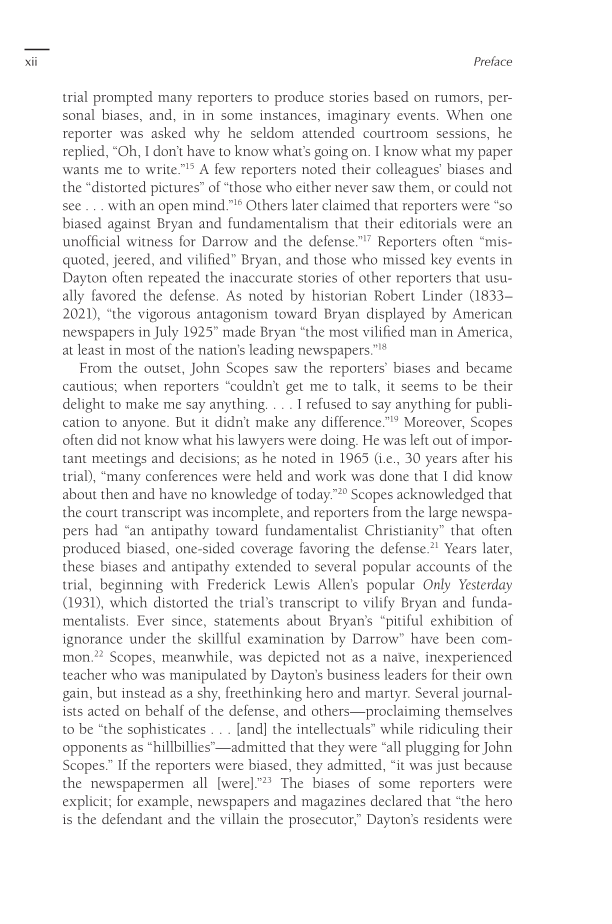xii Preface trial prompted many reporters to produce stories based on rumors, per- sonal biases, and, in in some instances, imaginary events. When one reporter was asked why he seldom attended courtroom sessions, he replied, “Oh, I don’t have to know what’s going on. I know what my paper wants me to write.”15 A few reporters noted their colleagues’ biases and the “distorted pictures” of “those who either never saw them, or could not see . . . with an open mind.”16 Others later claimed that reporters were “so biased against Bryan and fundamentalism that their editorials were an unofficial witness for Darrow and the defense.”17 Reporters often “mis- quoted, jeered, and vilified” Bryan, and those who missed key events in Dayton often repeated the inaccurate stories of other reporters that usu- ally favored the defense. As noted by historian Robert Linder (1833– 2021), “the vigorous antagonism toward Bryan displayed by American newspapers in July 1925” made Bryan “the most vilified man in America, at least in most of the nation’s leading newspapers.”18 From the outset, John Scopes saw the reporters’ biases and became cautious when reporters “couldn’t get me to talk, it seems to be their delight to make me say anything. . . . I refused to say anything for publi- cation to anyone. But it didn’t make any difference.”19 Moreover, Scopes often did not know what his lawyers were doing. He was left out of impor- tant meetings and decisions as he noted in 1965 (i.e., 30 years after his trial), “many conferences were held and work was done that I did know about then and have no knowledge of today.”20 Scopes acknowledged that the court transcript was incomplete, and reporters from the large newspa- pers had “an antipathy toward fundamentalist Christianity” that often produced biased, one-sided coverage favoring the defense.21 Years later, these biases and antipathy extended to several popular accounts of the trial, beginning with Frederick Lewis Allen’s popular Only Yesterday (1931), which distorted the trial’s transcript to vilify Bryan and funda- mentalists. Ever since, statements about Bryan’s “pitiful exhibition of ignorance under the skillful examination by Darrow” have been com- mon.22 Scopes, meanwhile, was depicted not as a naïve, inexperienced teacher who was manipulated by Dayton’s business leaders for their own gain, but instead as a shy, freethinking hero and martyr. Several journal- ists acted on behalf of the defense, and others—proclaiming themselves to be “the sophisticates . . . [and] the intellectuals” while ridiculing their opponents as “hillbillies”—admitted that they were “all plugging for John Scopes.” If the reporters were biased, they admitted, “it was just because the newspapermen all [were].”23 The biases of some reporters were explicit for example, newspapers and magazines declared that “the hero is the defendant and the villain the prosecutor,” Dayton’s residents were
Document Details My Account Print multiple pages
Print
You have printed 0 times in the last 24 hours.
Your print count will reset on at .
You may print 0 more time(s) before then.
You may print a maximum of 0 pages at a time.

























































































































































































































































































































